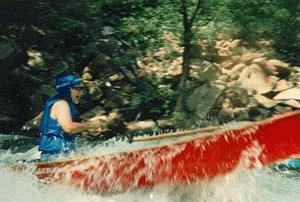Hiking and Climbing in Yosemite
Part 3: Hiking and Canoeing
-
Exhausted after the climb
in Part 2, you consider the design of a hiking trail with a gentler ascent.
Hiking trails generally do not rise much more than one foot for each five
feet horizontal. What value derivative does this correspond to? How does it
compare with the values of the derivatives in your table?
- To keep trails from following
a gentle, but unacceptably long, spiral to the summit, they're usually designed
to incorporate switchbacks: sharp turns in direction that nevertheless
keep the trail at a constant slope. See if you can draw a hiking trail on
your map, making a switchback roughly every 1000 ft, that starts at (0,0)
and arrives at your present position. How does the length w of
your trail compare with the length of your ascent in Part 2? (Capture the
map with your trail, and paste it into your report file.)
- Now start from the summit of Mt.
Watkins. Suppose you wish to descend as quickly as possible to Tenaya
Creek. Choose a sequence of points Pn, analogous to those
in Part 2, marking the path on your map. Again write a general formula that
gives Pn+1 in terms of Pn and grad f(Xn,Yn).
(Capture the map showing your descent trail, and paste it into your report
file.)
- Finally, you jump in a canoe and
start back toward Mirror Lake. What's the difference between following the
creek and simply continuing the iterations in step 3? Why does the creek follow
the path that it does?

Credit: Georgia
Canoeing Association
|
CCP Home | Materials | Multivariable
Calculus | Module Contents | Back
| Forward |
